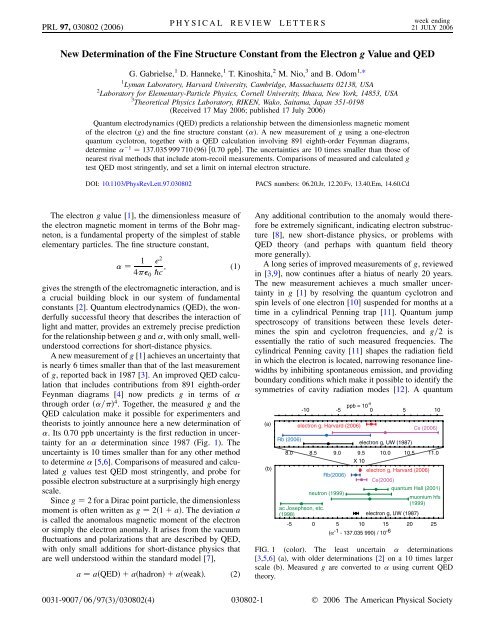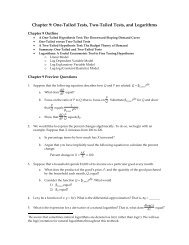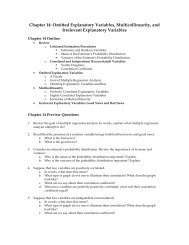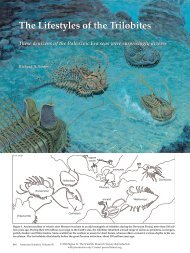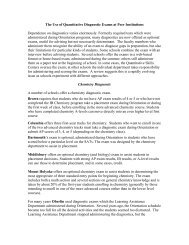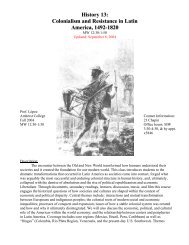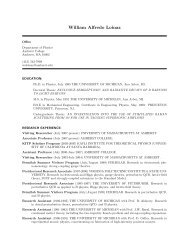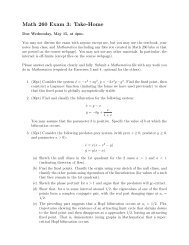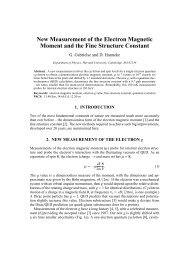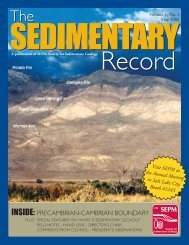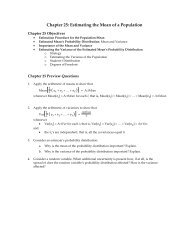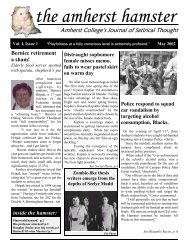New Determination of the Fine Structure Constant from the Electron ...
New Determination of the Fine Structure Constant from the Electron ...
New Determination of the Fine Structure Constant from the Electron ...
- No tags were found...
Create successful ePaper yourself
Turn your PDF publications into a flip-book with our unique Google optimized e-Paper software.
PRL 97, 030802 (2006)PHYSICAL REVIEW LETTERS week ending21 JULY 2006<strong>New</strong> <strong>Determination</strong> <strong>of</strong> <strong>the</strong> <strong>Fine</strong> <strong>Structure</strong> <strong>Constant</strong> <strong>from</strong> <strong>the</strong> <strong>Electron</strong> g Value and QEDG. Gabrielse, 1 D. Hanneke, 1 T. Kinoshita, 2 M. Nio, 3 and B. Odom 1, *1 Lyman Laboratory, Harvard University, Cambridge, Massachusetts 02138, USA2 Laboratory for Elementary-Particle Physics, Cornell University, Ithaca, <strong>New</strong> York, 14853, USA3 Theoretical Physics Laboratory, RIKEN, Wako, Saitama, Japan 351-0198(Received 17 May 2006; published 17 July 2006)Quantum electrodynamics (QED) predicts a relationship between <strong>the</strong> dimensionless magnetic moment<strong>of</strong> <strong>the</strong> electron (g) and <strong>the</strong> fine structure constant ( ). A new measurement <strong>of</strong> g using a one-electronquantum cyclotron, toge<strong>the</strong>r with a QED calculation involving 891 eighth-order Feynman diagrams,determine1137:035 999 710 96 0:70 ppb . The uncertainties are 10 times smaller than those <strong>of</strong>nearest rival methods that include atom-recoil measurements. Comparisons <strong>of</strong> measured and calculated gtest QED most stringently, and set a limit on internal electron structure.DOI: 10.1103/PhysRevLett.97.030802PACS numbers: 06.20.Jr, 12.20.Fv, 13.40.Em, 14.60.CdThe electron g value [1], <strong>the</strong> dimensionless measure <strong>of</strong><strong>the</strong> electron magnetic moment in terms <strong>of</strong> <strong>the</strong> Bohr magneton,is a fundamental property <strong>of</strong> <strong>the</strong> simplest <strong>of</strong> stableelementary particles. The fine structure constant,1 e 24 0 @c ; (1)gives <strong>the</strong> strength <strong>of</strong> <strong>the</strong> electromagnetic interaction, and isa crucial building block in our system <strong>of</strong> fundamentalconstants [2]. Quantum electrodynamics (QED), <strong>the</strong> wonderfullysuccessful <strong>the</strong>ory that describes <strong>the</strong> interaction <strong>of</strong>light and matter, provides an extremely precise predictionfor <strong>the</strong> relationship between g and , with only small, wellunderstoodcorrections for short-distance physics.A new measurement <strong>of</strong> g [1] achieves an uncertainty thatis nearly 6 times smaller than that <strong>of</strong> <strong>the</strong> last measurement<strong>of</strong> g, reported back in 1987 [3]. An improved QED calculationthat includes contributions <strong>from</strong> 891 eighth-orderFeynman diagrams [4] now predicts g in terms <strong>of</strong>through order = 4 . Toge<strong>the</strong>r, <strong>the</strong> measured g and <strong>the</strong>QED calculation make it possible for experimenters and<strong>the</strong>orists to jointly announce here a new determination <strong>of</strong>. Its 0.70 ppb uncertainty is <strong>the</strong> first reduction in uncertaintyfor an determination since 1987 (Fig. 1). Theuncertainty is 10 times smaller than for any o<strong>the</strong>r methodto determine [5,6]. Comparisons <strong>of</strong> measured and calculatedg values test QED most stringently, and probe forpossible electron substructure at a surprisingly high energyscale.Since g 2 for a Dirac point particle, <strong>the</strong> dimensionlessmoment is <strong>of</strong>ten written as g 2 1 a . The deviation ais called <strong>the</strong> anomalous magnetic moment <strong>of</strong> <strong>the</strong> electronor simply <strong>the</strong> electron anomaly. It arises <strong>from</strong> <strong>the</strong> vacuumfluctuations and polarizations that are described by QED,with only small additions for short-distance physics thatare well understood within <strong>the</strong> standard model [7],a a QED a hadron a weak : (2)Any additional contribution to <strong>the</strong> anomaly would <strong>the</strong>reforebe extremely significant, indicating electron substructure[8], new short-distance physics, or problems withQED <strong>the</strong>ory (and perhaps with quantum field <strong>the</strong>orymore generally).A long series <strong>of</strong> improved measurements <strong>of</strong> g, reviewedin [3,9], now continues after a hiatus <strong>of</strong> nearly 20 years.The new measurement achieves a much smaller uncertaintyin g [1] by resolving <strong>the</strong> quantum cyclotron andspin levels <strong>of</strong> one electron [10] suspended for months at atime in a cylindrical Penning trap [11]. Quantum jumpspectroscopy <strong>of</strong> transitions between <strong>the</strong>se levels determines<strong>the</strong> spin and cyclotron frequencies, and g=2 isessentially <strong>the</strong> ratio <strong>of</strong> such measured frequencies. Thecylindrical Penning cavity [11] shapes <strong>the</strong> radiation fieldin which <strong>the</strong> electron is located, narrowing resonance linewidthsby inhibiting spontaneous emission, and providingboundary conditions which make it possible to identify <strong>the</strong>symmetries <strong>of</strong> cavity radiation modes [12]. A quantum(a)(b)Rb (2006)ppb = 10 -9-10 -5 0 5 10electron g, Harvard (2006)8.0 8.5 9.0 9.5 10.0 10.5 11.0ac Josephson, etc.(1998)Rb(2006)neutron (1999)X 10electron g, UW (1987)electron g, Harvard (2006)Cs(2006)quantum Hall (2001)electron g, UW (1987)Cs (2006)muonium hfs(1999)-5 0 5 10 15 20 25(α -1 - 137.035 990) / 10 -6FIG. 1 (color). The least uncertain determinations[3,5,6] (a), with older determinations [2] on a 10 times largerscale (b). Measured g are converted to using current QED<strong>the</strong>ory.0031-9007=06=97(3)=030802(4) 030802-1 © 2006 The American Physical Society
PRL 97, 030802 (2006)PHYSICAL REVIEW LETTERS week ending21 JULY 2006nondemolition coupling <strong>of</strong> <strong>the</strong> cyclotron and spin energiesto <strong>the</strong> frequency <strong>of</strong> an orthogonal and nearly harmonicelectron oscillation, reveals <strong>the</strong> quantum state [10]. Thisharmonic oscillation <strong>of</strong> <strong>the</strong> electron is self-excited [13], bya signal derived <strong>from</strong> its own motion, to produce <strong>the</strong> largesignal-to-noise ratio needed to quickly read out <strong>the</strong> quantumstate without ambiguity.The preceding Letter [1] reports <strong>the</strong> new measurement,g=2 1:001 159 652 180 85 76 0:76 ppt : (3)The largest contribution to <strong>the</strong> 7:6 10 13 uncertaintyarises <strong>from</strong> an imperfect line shape model (0.6 ppt); likelythis can be understood and reduced with careful study.Extremely small magnetic field instabilities are one possiblecause. The second source <strong>of</strong> uncertainty is cavityshifts (0.4 ppt), caused when <strong>the</strong> cyclotron frequency <strong>of</strong>an electron in <strong>the</strong> trap cavity is shifted by interactions withcavity radiation modes that are near in frequency. Thefrequencies <strong>of</strong> cavity radiation modes are measured wellenough to identify <strong>the</strong> spatial symmetry <strong>of</strong> <strong>the</strong> modes, andto calculate and correct for cavity shifts to g <strong>from</strong> <strong>the</strong>known electromagnetic field configurations. A smallerthird uncertainty is statistical (0.2 ppt), and could be reducedwith more measurements.QED calculations involving many Feynman diagramsprovide <strong>the</strong> coefficients for expansions in powers <strong>of</strong> <strong>the</strong>small ratio = 2 10 3 . The QED anomalya QED A 1 A 2 m e =m A 2 m e =mA 3 m e =m ;m e =m ; (4)is a function <strong>of</strong> lepton mass ratios. Each A i is a series,A i A 2i A 4i2A 6i3...: (5)ppt ppb ppmweakhadronic(α/π) 4(α/π) 3(α/π) 2µτττµµ(α/π)1Harvard 0610 -15 10 -12 10 -9 10 -6 10 -3 10 0contribution to g/2 = 1 + aFIG. 2 (color). Contributions to g=2 for <strong>the</strong> experiment(green), terms in <strong>the</strong> QED series (black), and <strong>from</strong> short-distancephysics (blue). Uncertainties are in red. The , , andindicate terms dependent on mass ratios m e =m , m e =m and<strong>the</strong> two ratios, m e =m and m e =m , respectively.The calculations are so elaborate that isolating and eliminatingmistakes is a substantial challenge, as is determiningand propagating numerical integration uncertainties.Figure 2 compares <strong>the</strong> contributions and uncertaintiesfor g=2. The leading constants for second [14], fourth [15–17], and sixth [18–22] orders,A 210:5; (6)A 410:328 478 965 579 . . . ; (7)A 611:181 241 456 587 . . . ; (8)have been evaluated exactly. The latter confirms <strong>the</strong> value1:181 259 4 obtained numerically [23]. Very small massdependentQED additions [24–29],A 42m e =m 5:197 386 70 28 10 7 ;A 42m e =m 1:837 62 60 10 9 ;A 62 m e =m 7:373 941 64 29 10 6 ;A 62m e =m 6:581 9 19 10 8 ;A 63m e =m ;m e =m 0:190 945 62 10 12 ;are exactly known functions <strong>of</strong> <strong>the</strong> lepton mass ratios [30],<strong>from</strong> which <strong>the</strong>y derive <strong>the</strong>ir uncertaintyCrucial progress came in evaluating, checking, and determining<strong>the</strong> uncertainty in <strong>the</strong> eighth order A 81 , whichincludes contributions <strong>of</strong> 891 Feynman diagrams. Typicaldiagrams <strong>of</strong> <strong>the</strong> 13 gauge invariant subgroups are shown inFig. 3. Integrals <strong>of</strong> 373 <strong>of</strong> <strong>the</strong>se have been verified (andcorrected) by more than one independent formulation[4,31]. Verification <strong>of</strong> <strong>the</strong> 518 diagrams with no closedlepton loops is in progress using an automating algorithm[32]. Their renormalization terms are derived by systematicreduction <strong>of</strong> original integrands applying a simplepower-counting rule [33], allowing extensive crosscheckingamong <strong>the</strong>mselves and with exactly known diagrams<strong>of</strong> lower order [34]. Numerical integrations withVEGAS [35], on many supercomputers over more than10 years, <strong>the</strong>n yields [4]A 811:7283 35 : (10)The uncertainty, determined using estimated errors <strong>from</strong>I(a) I(b) I(c) I(d) II(a) II(b) II(c)III IV(a) IV(b) IV(c) IV(d) VFIG. 3. Typical diagrams <strong>from</strong> each gauge invariant subgroupthat contributes to <strong>the</strong> eighth-order electron magnetic moment.Solid and wiggly curves represent <strong>the</strong> electron and photon,respectively. Solid horizontal lines represent <strong>the</strong> electron in anexternal magnetic field.(9)030802-2
PRL 97, 030802 (2006)PHYSICAL REVIEW LETTERS week ending21 JULY 2006VEGAS, is improved by an order <strong>of</strong> magnitude over <strong>the</strong>previous value [36].The high experimental precision makes <strong>the</strong> tenth-ordercontribution to g potentially important if <strong>the</strong> unknown A 101is unexpectedly large, though this seems unlikely. To get afeeling for its possible impact we use a boundjA 101j 34 000 TeV=c 2 and R 130 GeV=c 2 and R 600 GeV.What <strong>the</strong>ory improvements might be expected in <strong>the</strong>future? The <strong>the</strong>ory contribution to <strong>the</strong> uncertainty in <strong>the</strong>new is already less than that <strong>from</strong> experiment by a factor<strong>of</strong> 3. The eighth-order uncertainty in A 81can be reducedwith <strong>the</strong> accumulation <strong>of</strong> better statistics in <strong>the</strong> numericalevaluation <strong>of</strong> integrals. Ambitious efforts underway aimfor a complete analytic evaluation, <strong>the</strong>reby entirely removingthis uncertainty [44]. A calculation <strong>of</strong> <strong>the</strong> tenth-ordercoefficient, A 101, is needed if an with smaller uncertaintiesis ever to be deduced <strong>from</strong> a better g. The evaluation isa formidable challenge given <strong>the</strong> mentioned contributions<strong>from</strong> 12 672 Feynman diagrams. Considerable progress insetting up and integrating many <strong>of</strong> <strong>the</strong>se diagrams has beenreported [32,45]. It now seems feasible to evaluate A 101toa few percent.030802-3
PRL 97, 030802 (2006)PHYSICAL REVIEW LETTERS week ending21 JULY 2006What experimental improvements can be expected?Experiments underway aim to substantially reduce <strong>the</strong>uncertainty in atom-recoil measurements that currentlycontribute <strong>the</strong> largest uncertainty to independent determinations<strong>of</strong> [46,47]. The preceding Letter [1] mentionsnew methods that may fur<strong>the</strong>r reduce <strong>the</strong> uncertainty in <strong>the</strong>electron g. This fully quantum measurement has only beenrecently realized, so much remains to be explored andoptimized.In conclusion, <strong>the</strong> fine structure constant is determinedwith much smaller uncertainty than in <strong>the</strong> past by a newmeasurement <strong>of</strong> <strong>the</strong> electron g and improved QED <strong>the</strong>ory.The absence <strong>of</strong> electron substructure is assumed, and onlysmall corrections for short-distance scale physics areneeded. The new has a 10 times smaller uncertaintythan that <strong>from</strong> any o<strong>the</strong>r method. Comparing <strong>the</strong> <strong>from</strong>g and QED, to <strong>the</strong> determined independently with Cs andRb, shows that QED continues to be a superb description <strong>of</strong><strong>the</strong> interaction <strong>of</strong> light and matter. A QED test that is 10times more stringent is possible with <strong>the</strong> current uncertaintiesin g and <strong>the</strong> QED calculation, if ever an independent<strong>of</strong> g is determined with <strong>the</strong> uncertainty reported here.Comparing <strong>the</strong> measured and calculated g sets a limit onpossible electric substructure at <strong>the</strong> 130 GeV level, againlimited by <strong>the</strong> uncertainty in independent determinations<strong>of</strong> , not by uncertainties in g or QED calculations.Experiments at Harvard were supported by <strong>the</strong> NSFAMO experimental program. Theory work by T. K. wassupported by <strong>the</strong> NSF <strong>the</strong>ory program <strong>of</strong> <strong>the</strong> U. S., <strong>the</strong>Eminent Scientist Invitation Program <strong>of</strong> RIKEN, Japan,and a grant-in-aid <strong>from</strong> Japan’s Ministry <strong>of</strong> Education,Science and Culture. M. N. was partly supported by aJSPS grant-in-aid, and used computational resources <strong>of</strong><strong>the</strong> RIKEN Super Combined Cluster System. Helpful commentscame <strong>from</strong> N. Arkani-Hamed, D. Hertzog, M. Morii,and J. Rosner.*Present address: University <strong>of</strong> Chicago, Chicago, IL60637, USA.[1] B. Odom, D. Hanneke, B. D’Urso, and G. Gabrielse, Phys.Rev. Lett. 97, 030801 (2006).[2] P. J. Mohr and B. N. Taylor, Rev. Mod. Phys. 77, 1 (2005).[3] R. S. Van Dyck, Jr., P. B. Schwinberg, and H. G. Dehmelt,Phys. Rev. Lett. 59, 26 (1987).[4] T. Kinoshita and M. Nio, Phys. Rev. D 73, 013003 (2006).[5] P. Cladé, E. de Mirandes, M. Cadoret, S. Guellati-Khélifa,C. Schwob, F. Nez, L. Julien, and F. Biraben, Phys. Rev.Lett. 96, 033001 (2006).[6] V. Gerginov, K. Calkins, C. E. Tanner, J. McFerran,S. Diddams, A. Bartels, and L. Hollberg, Phys. Rev. A73, 032504 (2006).[7] A. Czarnecki, B. Krause, and W. J. Marciano, Phys. Rev.Lett. 76, 3267 (1996).[8] S. J. Brodsky and S. D. Drell, Phys. Rev. D 22, 2236(1980).[9] A. Rich and J. C. Wesley, Rev. Mod. Phys. 44, 250 (1972).[10] S. Peil and G. Gabrielse, Phys. Rev. Lett. 83, 1287 (1999).[11] G. Gabrielse and F. C. MacKintosh, Int. J. Mass Spectrom.Ion Processes 57, 1 (1984).[12] J. Tan and G. Gabrielse, Phys. Rev. Lett. 67, 3090 (1991).[13] B. D’Urso, R. Van Handel, B. Odom, D. Hanneke, andG. Gabrielse, Phys. Rev. Lett. 94, 113002 (2005).[14] J. Schwinger, Phys. Rev. 73, 416L (1948).[15] C. M. Sommerfield, Phys. Rev. 107, 328 (1957).[16] C. M. Sommerfield, Ann. Phys. (N.Y.) 5, 26 (1958).[17] A. Petermann, Helv. Phys. Acta 30, 407 (1957).[18] S. Laporta and E. Remiddi, Phys. Lett. B 265, 182(1991).[19] S. Laporta, Phys. Rev. D 47, 4793 (1993).[20] S. Laporta and E. Remiddi, Phys. Lett. B 356, 390(1995).[21] S. Laporta, Phys. Lett. B 343, 421 (1995).[22] S. Laporta and E. Remiddi, Phys. Lett. B 379, 283(1996).[23] T. Kinoshita, Phys. Rev. Lett. 75, 4728 (1995).[24] M. A. Samuel and G. Li, Phys. Rev. D 44, 3935 (1991).[25] G. Li, R. Mendel, and M. A. Samuel, Phys. Rev. D 47,1723 (1993).[26] A. Czarnecki and M. Skrzypek, Phys. Lett. B 449, 354(1999).[27] S. Laporta, Nuovo Cimento A 106, 675 (1993).[28] S. Laporta and E. Remiddi, Phys. Lett. B 301, 440 (1993).[29] B. Lautrup, Phys. Lett. B 69, 109 (1977).[30] M. Passera, hep-ph/0606174.[31] T. Kinoshita and M. Nio, Phys. Rev. Lett. 90, 021803(2003).[32] T. Aoyama, M. Hayakawa, T. Kinoshita, and M. Nio,Nucl. Phys. B740, 138 (2006).[33] P. Cvitanovic and T. Kinoshita, Phys. Rev. D 10, 4007(1974).[34] T. Kinoshita, Theory <strong>of</strong> <strong>the</strong> Anomalous Magnetic Moment<strong>of</strong> <strong>the</strong> <strong>Electron</strong>—Numerical Approach (World Scientific,Singapore, 1990).[35] G. P. Lepage, J. Comput. Phys. 27, 192 (1978).[36] V. W. Hughes and T. Kinoshita, Rev. Mod. Phys. 71, S133(1999).[37] C. Schwob, L. Jozefowski, B. de Beauvoir, L. Hilico,F. Nez, L. Julien, F. Biraben, O. Acef, J. J. Zondy, andA. Clairon, Phys. Rev. Lett. 82, 4960 (1999).[38] M. P. Bradley, J. V. Porto, S. Rainville, J. K. Thompson,and D. E. Pritchard, Phys. Rev. Lett. 83, 4510 (1999).[39] T. Beier, H. Häffner, N. Hermanspahn, S. G. Karshenboim,H.-J. Kluge, W. Quint, S. Stahl, J. Verdú, and G. Werth,Phys. Rev. Lett. 88, 011603 (2002).[40] D. L. Farnham, R. S. Van Dyck, Jr., and P. B. Schwinberg,Phys. Rev. Lett. 75, 3598 (1995).[41] T. Udem, J. Reichert, R. Holzwarth, and T. W. Hänsch,Phys. Rev. Lett. 82, 3568 (1999).[42] A. Wicht, J. M. Hensley, E. Sarajlic, and S. Chu, Phys. Scr.T102, 82 (2002).[43] D. Bourilkov, Phys. Rev. D 64, 071701 (2001).[44] S. Laporta and E. Remiddi (private communication).[45] T. Kinoshita and M. Nio, Phys. Rev. D 73, 053007 (2006).[46] S. Chu (private communication).[47] F. Biraben (private communication).030802-4
PRL 99, 039902 (2007)PHYSICAL REVIEW LETTERS week ending20 JULY 2007Erratum: <strong>New</strong> <strong>Determination</strong> <strong>of</strong> <strong>the</strong> <strong>Fine</strong> <strong>Structure</strong> <strong>Constant</strong> <strong>from</strong> <strong>the</strong> <strong>Electron</strong> g Value and QED[Phys. Rev. Lett. 97, 030802 (2006)]DOI: 10.1103/PhysRevLett.99.039902G. Gabrielse, D. Hanneke, T. Kinoshita, M. Nio, and B. Odom(Received 25 June 2007; published 20 July 2007)PACS numbers: 06.20.Jr, 12.20.Fv, 13.40.Em, 14.60.Cd, 99.10.CdOur recent report [1] <strong>of</strong> <strong>the</strong> most precise determination <strong>of</strong> <strong>the</strong> fine structure constant was based upon a newmeasurement [2] <strong>of</strong>g=2 for <strong>the</strong> electron—<strong>the</strong> magnitude <strong>of</strong> <strong>the</strong> electron’s magnetic moment in Bohr magnetons.Equally crucial was a <strong>the</strong>oretical QED calculation involving 891 Feynman diagrams [3]. The value <strong>of</strong>1 changes to1 H06 137:035 999 070 12 37 90 (1)137:035 999 070 98 0:71 ppb (2)when <strong>the</strong> correction to a recently discovered QED evaluation error [4] is incorporated. The essentially unchangeduncertainties in Eq. (1) are <strong>from</strong> <strong>the</strong> numerical uncertainty <strong>of</strong> <strong>the</strong> eighth-order QED contribution, <strong>from</strong> an estimate <strong>of</strong><strong>the</strong> unknown tenth-order QED contribution (adjusted an insignificant amount to remain consistent with [5]), and <strong>from</strong> <strong>the</strong>uncertainty in <strong>the</strong> measured g. A reestimate <strong>of</strong> <strong>the</strong> hadronic light-by-light contribution [5,6] is also included forcompleteness, though it makes no significant change.An automated code generator [7], produced to calculate <strong>the</strong> tenth-order contribution to g=2, was used to examine <strong>the</strong> 518<strong>of</strong> 891 eighth-order QED diagrams that had no previous independent check—a check reported as being in progress in [1].Only 47 integrals represent <strong>the</strong> 518 vertex diagrams when <strong>the</strong> Ward-Takahashi identity and time-reversal invariance areused. A diagram-by-diagram comparison with <strong>the</strong> previous calculation [3] shows that 2 <strong>of</strong> <strong>the</strong> 47 require a correctedtreatment <strong>of</strong> infrared divergences [4]. The revised eighth-order contribution to g=2 is A 81= 4 , with A 811:9144 35 replacing Eq. (10) in Ref. [1].A summary <strong>of</strong> precise determinations (Fig. 1) differs <strong>from</strong> that <strong>of</strong> 1 yr ago [1]. The corrected QED evaluation shifts <strong>the</strong><strong>from</strong> <strong>the</strong> Harvard and University <strong>of</strong> Washington (UW) g measurements. The atom-recoil determination <strong>of</strong> Rb shiftsdue to an experimental correction [8]. The neutron is now shifted <strong>of</strong>f scale in light <strong>of</strong> reevaluations <strong>of</strong> <strong>the</strong> Si latticeconstant and its uncertainties (e.g., [9]).The comparisons <strong>of</strong> <strong>the</strong> measured a g=2 1 and that ‘‘calculated’’ using QED and <strong>the</strong> two independently measuredvalues [in Eqs. (19) and (20) <strong>of</strong> Ref. [1]] are nowa Cs06 a H06 7:9 9:3 10 12 ; (3)a Rb06 a H06 1:9 7:7 10 12 ; (4)ppb = 10 -9-10 -5 0 5 10 15(a)Rb (2006)g (Harvard, 2006)Cs (2006)(b)g (UW, 1987)8.0 8.5 9.0 9.5 10.0 10.5 11.0X 10g (Harvard, 2006)Rb(2006)Cs(2006)quantum Hall (2001)ac Josephson, etc. (1998)g (UW, 1987)muonium hfs (1999)-5 0 5 10 15 20 25(α -1 - 137.035 990) / 10 -6FIG. 1 (color). (a) Precise determinations, with (b) older determinations on a 10 times larger scale. References are in Ref. [1].0031-9007=07=99(3)=039902(2) 039902-1 © 2007 The American Physical Society
PRL 99, 039902 (2007)PHYSICAL REVIEW LETTERS week ending20 JULY 2007including <strong>the</strong> correction to Rb06 [8]. The good agreement, limited by <strong>the</strong> uncertainty in Cs06 and Rb06 , stilltestifies to <strong>the</strong> remarkable success <strong>of</strong> QED.Is it likely that o<strong>the</strong>r adjustments <strong>of</strong> <strong>the</strong> QED <strong>the</strong>ory will shift <strong>the</strong> that is determined <strong>from</strong> <strong>the</strong> electron g? We hope not,now that all eighth-order contributions have been checked independently by two or more methods for <strong>the</strong> first time. Whatcould fur<strong>the</strong>r shift this determination <strong>of</strong> would be a larger-than-expected tenth-order QED contribution to g=2—nowbeing evaluated using <strong>the</strong> new computational method that revealed <strong>the</strong> need for this update.[1] G. Gabrielse, D. Hanneke, T. Kinoshita, M. Nio, and B. Odom, Phys. Rev. Lett. 97, 030802 (2006).[2] B. Odom, D. Hanneke, B. D’Urso, and G. Gabrielse, Phys. Rev. Lett. 97, 030801 (2006).[3] T. Kinoshita and M. Nio, Phys. Rev. D 73, 013003 (2006).[4] T. Aoyama, M. Hayakawa, T. Kinoshita, and M. Nio, arXiv:0706.3496.[5] P. J. Mohr and B. N. Taylor, Rev. Mod. Phys. 77, 1 (2005).[6] K. Melnikov and A. Vainshtein, Phys. Rev. D 70, 113006 (2004); Theory <strong>of</strong> <strong>the</strong> Muon Anomalous Magnetic Moment (Springer,Berlin, 2006).[7] T. Aoyama, M. Hayakawa, T. Kinoshita, and M. Nio, Nucl. Phys. B740, 138 (2006).[8] P. Cladé, E. de Mirandes, M. Cadoret, S. Guellati-Khélifa, C. Schwob, F. Nez, L. Julien, and F. Biraben, Phys. Rev. A 74, 052109(2006).[9] P. Becker, G. Cavagnero, U. Kuetgens, G. Mana, and E. Massa, IEEE Trans. Instrum. Meas. 56, 230 (2007).039902-2


